- Home
- Knot Stitch
A Beginner’s Guide to the Coral Knot Stitch (for a Fabulously Bumpy Texture!)
Have you ever seen a piece of embroidery with a wonderfully bumpy, textured line and wondered, "How did they do that?" Chances are, you were admiring the lovely coral knot stitch.
And I have a secret to share: despite the word "knot" in its name, it's so much easier to master than you might think!
Unlike French knots that are stitched one by one, the coral knot stitch is worked in a row. Once you get into the rhythm, you'll be looking for excuses to add its delightful texture everywhere.
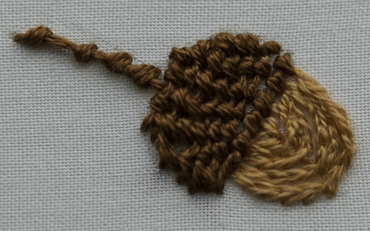 Coral knots used for acorn cup and stalk
Coral knots used for acorn cup and stalkFor example, I used rows of coral knot stitch to create the bumpy cap and sturdy stalk for this little acorn. It gives it a wonderful, touchable quality that contrasts so nicely with the smooth chain stitch of the nut itself.
Ready to create your own touchable textures? Let’s get started!
Working Coral Knot stitch
Before we begin, a quick word on supplies.
I find this stitch works up beautifully with a non-stranded thread like a pearl cotton. For this tutorial, I'm using a number 8 so you can see the knots clearly.
You might also find it easier to work this stitch "in the hand" (without an embroidery hoop) so you can scoop up the fabric with your needle. If you do, just be mindful not to pull your stitches too tight, or the fabric might pucker a bit.
Okay, let's make some knots!
Part 1: How to learn coral knot stitch
1. Get into position
We're going to work from right to left, which might feel a little quirky at first, but you'll get the hang of it.
To practice, bring your knotted thread up from the back of the fabric at the start of a marked line. While practising you can use a pencil, chalk or disappearing ink pen to draw your line.
2: Take the first scoop
Pop your needle down into the fabric just above your line.
Almost immediately, bring the tip back up just below the line. Don't pull the needle all the way through yet!
3. Tuck the thread under and pull
Take your working thread and lay it over the top of the needle.
- Now, tuck the thread underneath the needle's tip. It should look like the photo below:
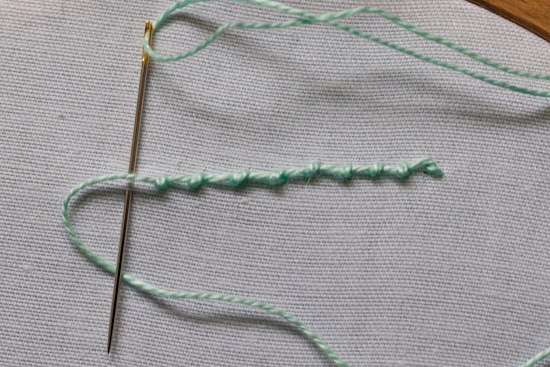 Working a row of coral knot stitch
Working a row of coral knot stitchGently pull your needle all the way through. Keep a slight, even tension on the thread, and you'll see a neat little knot settle right onto your line.
And that's it! You've made your first coral knot. See? I told you it was friendly.
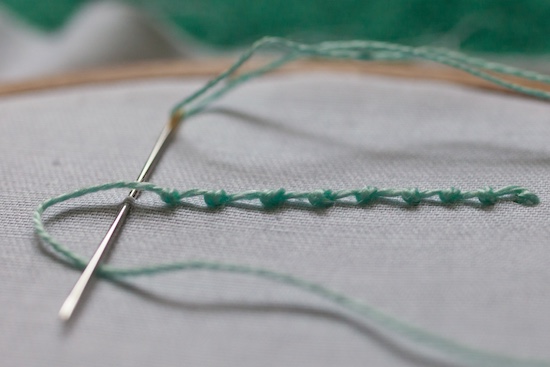 Coal knots seen from the side
Coal knots seen from the sidePart 2: Let's Practice Texture
Now that you have the basic movement down, let's play with it. On a scrap piece of fabric, let's practice controlling the texture.
First, stitch a row where you leave a little space between each knot, just like I did in the photo above.
Next, right below that, stitch another row, but this time, snuggle the knots right up next to each other.
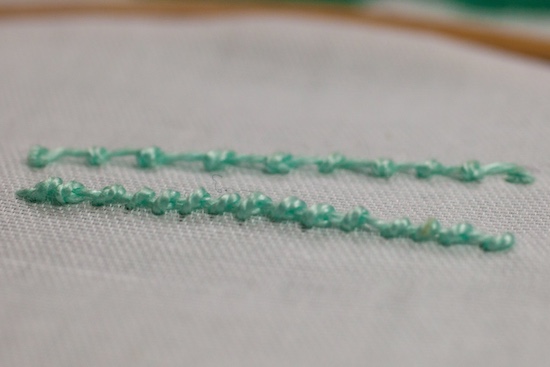 Knots worked close together
Knots worked close togetherLook at that! You've already learned how to create two completely different effects. The first one is great for delicate outlines and stems, while the second creates a bold, thick, rope-like line. How easy was that?
Part 3: A creative playground
Once you're feeling comfortable, you can start using the coral knot stitch to fill in shapes and add personality to your work. This is where the real fun begins!
Playing with filling
You can stitch rows close together to fill a shape. To change the look, you can try:
- Stacking the knots directly on top of the ones in the previous row
- Alternating the knots (or placing them randomly). This gives a more organic, bumpy feel that's perfect for natural motifs.
- Move the know in each subsequent row so it gradually forms a diagonal line. Take a look at that acorn cup up top again. Can you see the spiral effect I was aiming for?
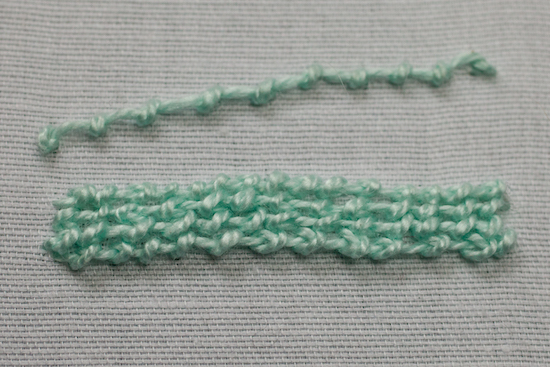 Coral knot stitch worked as a filling
Coral knot stitch worked as a fillingPlaying with Thread
Try a hand-dyed thread when filling an area. The subtle colour shifts will give a gorgeous, natural look.
Create a shaded effect by using a slightly different toned thread for each row.
Experiment with thread thickness. A single strand gives a delicate, beaded line, while using a thicker thread (or more strands of floss) creates a chunky, bold texture.
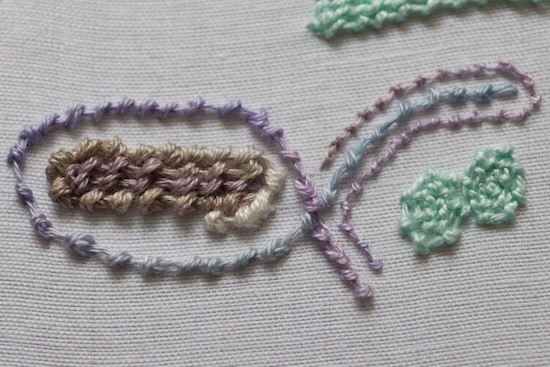 Coral knot sampler
Coral knot samplerFun Ways to Use Coral Knot Stitch
I don't know about you, but I'm a very visual person. I often stitch little samples just to see how things look.
In fact, I made a whole sampler just to compare my favorite stitches for working lines and outlines. It features this lovely coral knot right in the mix! Pop over and see the photo—it's so much easier to choose the right stitch when you can see them all together.
This stitch isn't just for straight lines! It's fantastic for:
- Curved stems and outlines for flowers
- Creating a woolly fleece on a stitched sheep
- Making textured tails for rabbits and squirrels
- Stitching bold, textured lettering, like the "L" I stitched on this crazy quilt block.
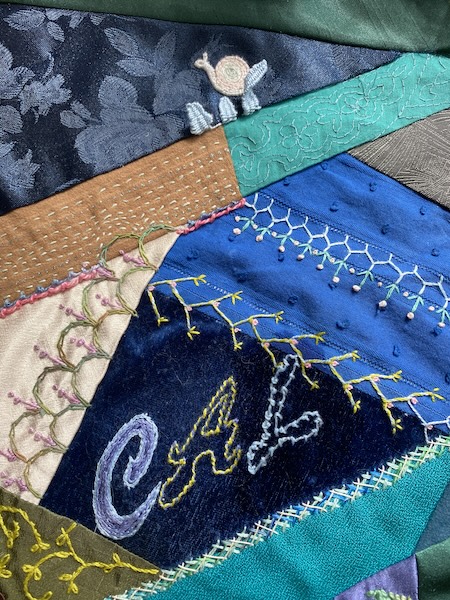
You can even work it in a spiral! There are no rules here, only creative possibilities.
So, give the coral knot stitch a try. Start with the basics, practice your spacing, and then let your imagination run wild. You’ll be adding fabulous, bumpy texture to your embroidery projects in no time!
Happy stitching!
Stay connected between projects
If you’d like occasional updates from my embroidery room, including new patterns, gentle tips, and little things I think you might enjoy, you’re warmly invited to join the Stitchin’ Times newsletter.
No pressure. Just a friendly note now and then to keep you inspired.


